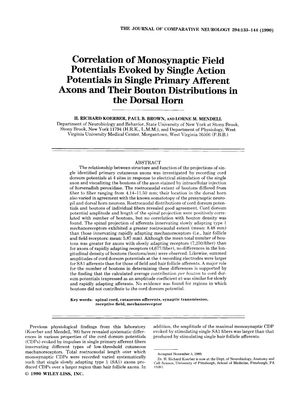Correlation of Monosynaptic Field Potentials Evoked by Single Action Potentials in Single Primary Afferent Axons and Their Bouton Distributions in the Dorsal Horn
April 1990
in “
Journal of comparative neurology
”

TLDR The study found that nerve signals are stronger when there are more connection points, but not necessarily denser, along the nerve's path in the spine.
The study investigated the relationship between the structure and function of single primary cutaneous axons by recording monosynaptic field potentials, known as cord dorsum potentials, and visualizing the axon's boutons. The boutons' distribution varied among fibers, with a length range of 4.14–11.50 mm, and their location corresponded with the known somatotopy. There was a positive correlation between the amplitude of cord dorsum potentials, the length of the spinal projection, and the number of boutons, but not with bouton density. Afferents connected to slowly adapting type 1 mechanoreceptors had a greater rostrocaudal extent (average 8.48 mm) and more boutons (average 7,250 per fiber) compared to those linked to rapidly adapting mechanoreceptors (average 5.87 mm and 4,677 boutons per fiber), although the longitudinal density of boutons was similar for both types. The summed amplitudes of cord dorsum potentials were larger for slowly adapting afferents, but the average contribution per bouton to these potentials was similar for both afferent types, suggesting the number of boutons plays a major role in the observed differences. No regions were found where boutons did not contribute to the cord dorsum potential.